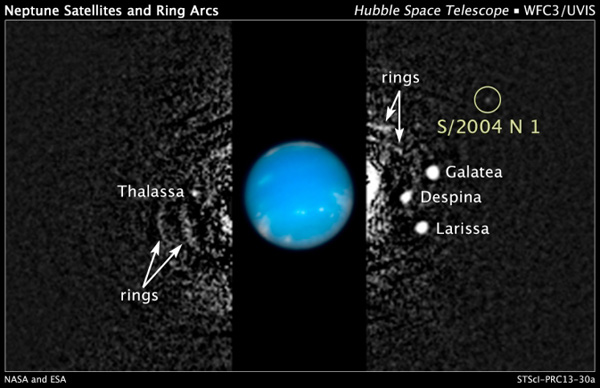The planet Neptune. Image via NASA, ESA, and M. Showalter (SETI Institute)
A new moon has been found orbiting the blue-green planet Neptune in our solar system! NASA’s Hubble space telescope has detected the new moon, now the 14th such moon known to be circling the giant Neptune. Yet, this moon is teeny – it seems that its expanse is no more than 19 kilometres (12 miles) across – making it the smallest known moon in the Neptunian system.
The moon has been given the name S/2004 N.
Mark Showalter of the SETI Institute in Mountain View, California, discovered the moon on 1 July, while studying the faint arcs, or segments of rings, around Neptune, NASA confirmed today.
In our solar system, Neptune is the farthest major planet from our sun. It is the fourth-largest planet by diameter and the third-largest by mass. Amidst the gaseous planets in the solar system, Neptune is the most dense. Neptune is 17 times the mass of planet Earth.
Trotting around our solar system
It was the summer of 1989 that NASA’s Voyager 2 sped past Neptune during its solar-system tour that kicked off on 20 August 1977. During its brief fly-by of Neptune in 1989, the Voyager 2 spacecraft managed to take a good few photos in and around Neptune.
At the time, the robotic probe discovered several moons orbiting close to the planet – 13 to be exact.
Yet, there was one elusive moon. No bigger than a small Irish town and nearly coal black, the moon evaded being detected because it was too faint to be seen. That was until now …
S/2004 N and how it was eventually hunted down
“The moons and arcs orbit very quickly, so we had to devise a way to follow their motion in order to bring out the details of the system,” Showalter said. “It’s the same reason a sports photographer tracks a running athlete – the athlete stays in focus, but the background blurs.”
Apparently, the method the astronomers used to capture the moon involved tracking the movement of a white dot that appears over and over again in more than 150 archival Neptune photographs taken by Hubble between 2004 to 2009.
On a whim, on 1 July, Showalter said he looked far beyond the ring segments and noticed the white dot about 105,250 kilometres (65,400 miles) from Neptune, located between the orbits of the Neptunian moons Larissa and Proteus.
The dot is S/2004 N 1. Showalter then plotted a circular orbit for the moon, which, it seems, completes one revolution around Neptune every 23 hours.
As for the Hubble space telescope, it is a co-operative project between NASA and the European Space Agency.
NASA’s Goddard Space Flight Center in Greenbelt, Maryland, manages the telescope.
The Space Telescope Science Institute (STScI) in Baltimore conducts Hubble science operations. STScI is operated by the Association of Universities for Research in Astronomy in Washington.

This composite Hubble space telescope picture shows the location of a newly discovered moon, designated S/2004 N 1, orbiting Neptune. The black and white image was taken in 2009 with Hubble’s Wide Field Camera 3 in visible light. Hubble took the colour inset of Neptune on August 2009. Image via NASA, ESA, M. Showalter/SETI Institute